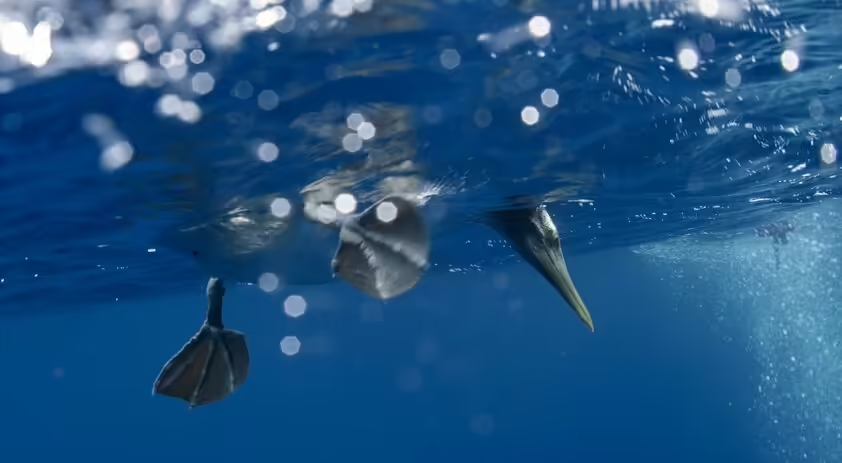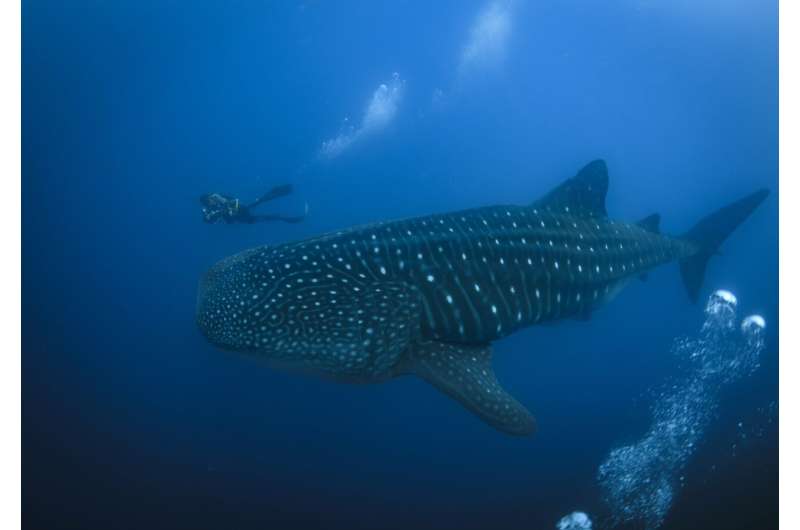Galapagos Islands under threat from warming waters
- July 29, 2024
- 0
Warm morning light reflects off the remains of a natural rock arch near Darwin Island, one of the most remote islands of the Galapagos Islands, where thousands of
Warm morning light reflects off the remains of a natural rock arch near Darwin Island, one of the most remote islands of the Galapagos Islands, where thousands of

Warm morning light reflects off the remains of a natural rock arch near Darwin Island, one of the most remote islands of the Galapagos Islands, where thousands of creatures—fish, hammerhead sharks, marine iguanas—move in search of food in the clear, dark-blue waters.
Darwin’s Belt, named after the famous British naturalist behind the theory of evolution, collapsed due to natural erosion in 2021. But its demise underlined the fragility of the vast archipelago, which is under increasing pressure from both climate change and invasive species.
Warming oceans are affecting the food sources of many marine animals in the Galapagos. Marine iguanas, one of many species native or endemic to the Galapagos Islands, are having difficulty finding the red and green algae they prefer. Sea turtles have difficulty nesting in high temperatures. Raising young becomes more difficult as water warms and nutrients become scarce.
Although the Galapagos Islands are known for their large number of species, their numbers are not unlimited.
Naturalist guide Natasha Cabezas, “There’s a little bit of everything here – that’s why people say the Galapagos is so diverse – but there’s a little bit of everything” said.
The Galapagos Islands have always been sensitive to changes in ocean temperature. The archipelago itself is located where the main ocean currents converge – cool from the south, warm from the north and cold from the west upwards. There is also El Niño, a periodic natural warming of the Pacific Ocean that affects weather worldwide.

While temperatures vary with the seasons and other natural climate events, ocean temperatures are increasing due to human-caused climate change, as the oceans absorb the vast majority of excess heat in the atmosphere. The ocean has experienced its warmest decade since at least the 1800s in the past 10 years, and 2023 is the ocean’s warmest year on record.
In early June, winter begins in the Southern Hemisphere, and the Cromwell Current brings whale sharks, hammerheads and giant sunfish to the surface. It also provides food for foraging penguins, marine iguanas and sea lions. As more and more animals emerge this season, scientists are monitoring how well they fared during last year’s El Niño warming.
El Niño can lead to food shortages for some species, such as marine iguanas and sea turtles, because a warmer ocean means fewer food sources. Scientists who monitor this species have noticed a significant decrease in population size during El Niño events.
As the waves crash against the shores of Fernandina Island, marine iguanas snake from rock to rock in the water. They cling to rocks underwater to feed on the algae that grow there, and sea lions circle them like puppies, looking for someone to play with.
Jorge Carrion, Galapagos Conservation Director, Iguanas “It was one of the species most affected by last year’s El Niño and is still recovering.” told.
While rising ocean temperatures threaten aquatic and marine life, there is another problem on land: non-native wildlife such as cats, dogs, pigs, goats and cattle threaten the islands’ unique species.
Cabezas said that since the COVID-19 pandemic, many people have abandoned dogs and cats that they wanted to keep company with.
“If you don’t take care of them, they become a problem and it’s a shame to see dogs everywhere now. We have a big problem now, I don’t know what to do,” he said.
Non-native animals pose a particular threat to giant tortoises, which are closely associated with the Galapagos Islands. Their numbers declined significantly in the 19th century due to hunting and poaching, and authorities worked to protect them from humans. Since 1933, it has been illegal to kill giant tortoises.
Carrion, “In one night, a wild boar can destroy all the nesting sites in an area” Park rangers try to visit the nesting areas once a day and kill the pigs when they are found. But Carrion said the pigs are hard to find.
Feral cats feed on marine iguanas, while pigs and cats compete with turtles for food. If invasive species and warming oceans aren’t enough, there’s also the widespread problem of plastic in the world’s oceans. A recent study found microplastics in the stomachs of Galapagos penguins.
Carrion, “There is no animal on the Galapagos Islands that does not have microplastics in its food” said.
Source: Port Altele
As an experienced journalist and author, Mary has been reporting on the latest news and trends for over 5 years. With a passion for uncovering the stories behind the headlines, Mary has earned a reputation as a trusted voice in the world of journalism. Her writing style is insightful, engaging and thought-provoking, as she takes a deep dive into the most pressing issues of our time.